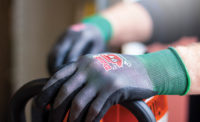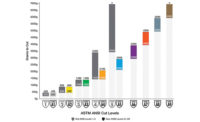With all of the different options available on the market these days, it’s understandable that choosing the perfect pair of work gloves can seem daunting. Depending on the type of industry you work in or the application you require gloves for, certain types of gloves are more suitable than others. To determine which gloves are right for you, many different aspects need to be taken into consideration (you can thank all of the technological advancements in the glove manufacturing world in recent years). Which types of hazards are you likely to encounter while you’re on the job? Are there multiple hazards? Will your hands get wet? Do you need protection against cut or puncture hazards?
These questions are important ones to ask. If you’re going to be working around saws or sharp metal, you don’t want to be wearing gloves that don’t offer cut resistance. If you work in the oil and gas industry, you don’t want work gloves that can’t grip tools or materials in slippery conditions. And the list goes on.
Do your research
While choosing gloves crafted with high performance materials such as Kevlar® or Dyneema® is always smart, take time to learn about the many palm coatings available and their benefits. Palm coatings add another layer of protection to your gloves: not only do they offer the same level of comfort you would expect from a traditional knit glove, they also make your gloves that much more useful. Choosing the right palm coating can boost cut resistance, reduce friction, and even give you a grip that’s worthy of a super hero.
There are five main types of work glove palm coatings: latex, polyurethane, PVC, nitrile, and foam nitrile. Each of these coatings are advantageous for different reasons; some are better for certain applications and industries.
Here’s a breakdown of strengths and weaknesses for each of the coatings:
Latex
Though they often get a bad rap, latex-coated gloves are soft, dexterous, and very durable. Latex doesn’t offer much protection against cuts or punctures, but it provides a strong grip, and withstands both extreme temperatures and tearing. If chemicals are a hazard in your workplace, latex also resists alcohols and some ketones, though as a general rule, it doesn’t perform well in the presence of hydrocarbons and organic solvents.
For all of these reasons, latex-coated gloves are an excellent choice for many applications.
Polyurethane
If you’re looking for a glove coating that’s extremely flexible, relatively inexpensive, and has a low particulate shed, polyurethane might be a good choice. It’s not the most durable coating, but polyurethane will provide you with a phenomenal grip without ever feeling sticky – meaning that you won’t have to worry about using finishing processes or substances like powder or chlorination to deal with stickiness. It also provides excellent protection against oils and greases, though it has poor water and heat resistance.
PVC
PVC is so versatile and inexpensive it is one of the most commonly used coatings for work gloves. Also, since it’s 100 percent synthetic, it won’t cause allergic reactions – making it a popular substitute for latex in workplaces where allergies are an issue.
Though PVC isn’t the best choice for those who require protection against cut and puncture hazards, PVC offers excellent abrasion resistance. It’s also good in applications like woodworking and automotive assembly, since unlike other types of coatings, adhesives won’t stick to it. Since it doesn’t lose its flexibility in colder temperatures, it’s also a good option for those in need of palm-coated winter gloves.
Nitrile
For those who can’t wear work gloves with latex components, nitrile is another excellent substitute. It’s three times more puncture-resistant than the rubber used to make work gloves, and provides great puncture and tear resistance. It isn’t flame-resistant, but it performs very well in -4˚C (25˚F) to 149˚C (300˚F) temperatures. Since it’s very durable and will give you a good grip, nitrile is also a popular choice for those who require general purpose gloves. But if you’re in search of a glove with a strong wet grip, your best bet is to go with…
Foam Nitrile
For those who work in oily and wet conditions on a regular basis, gloves with foam nitrile coatings are unparalleled in the workplace. Nitrile provides excellent comfort and dexterity; when foamed, it behaves like a sponge by soaking up oil and displacing it. Your hands won’t slip when trying to get a hold on oily metal parts. One type of foam nitrile coating is infused with millions of tiny pores using “micropore” technology. When the coating comes into contact with smooth surfaces, it displaces the oils and liquids, creating a kind of suction that results in a strong grip. If you work with slippery parts, foam nitrile coated gloves are what you need.
Don’t forget to consider all of the different risks in your workplace, and consult the latest ASTM and EN388 testing standards in order to determine which levels of protection against certain workplace hazards you need. Wearing palm-coated work gloves will not only improve your performance – it will also increase your level of safety by a wide margin.





